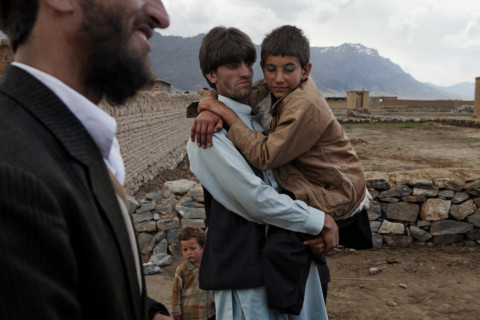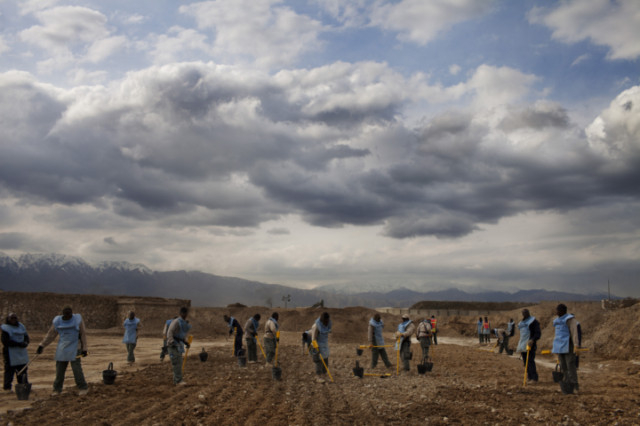
As the United States’ military withdraws from Afghanistan, it is leaving behind a deadly legacy: about 2,070 square kilometres of land littered with undetonated grenades, rockets and mortar shells.
The military has vacated scores of firing ranges pocked with the explosives. Dozens of children have been killed or wounded as they have stumbled upon the ordnance at the sites, which are often poorly marked. Casualties are likely to increase sharply; the US military has removed the munitions from only 3 per cent of the territory covered by its sprawling ranges, officials said.
Clearing the rest of the contaminated land — which in total is twice as big as New York City — could take two to five years. US military officials say they intend to clean up the ranges. But because of a lack of planning, officials say, funding has not yet been approved for the monumental effort, which is expected to cost $250 million (Dh918 million).
“Unfortunately, the thinking was ‘We’re at war and we don’t have time for this,’” said Major Michael Fuller, the head of the US Army’s Mine Action Center at Bagram Airfield, referring to the planning.
There are a growing number of tragedies at these high-explosive ranges.
Mohammad Yousuf, 13, and Sayed Jawad, 14, grew up 90 metres from a firing range used by US and Polish troops in Ghazni province. The boys’ families were accustomed to the thundering explosions from military training exercises, which sometimes shattered windows in their village.
But as those blasts became less common — a function of the US and Nato withdrawal — the boys started wandering on to the range to collect scrap metal to sell. They did not know that some US explosives do not detonate on impact but can still blow up when someone touches them.
Last month, Jawad’s father, Sayed Sadeq, heard a boom and ran on to the range. He spotted his son’s bloodied torso.
“The left side of his body was torn up. I could see his heart. His legs were missing,” the father said.
One of the boys, it appeared, had stepped on a 40mm grenade, designed to kill anyone within 5 metres. Both teens died.
“If the Americans believe in human rights, how can they let this happen?” Sadeq said.
Since 2012, the UN’s Mine Action Coordination Center of Afghanistan has recorded 70 casualties in and around US or Nato firing ranges or bases, and the pace of the incidents has been quickening. But the statistics don’t paint a complete picture; The Washington Post found 14 casualties who were not included in the UN data, including Yousuf and Jawad.
Most of the victims were taking their animals to graze, collecting firewood or searching for scrap metal. Of the casualties recorded by the UN, 88 per cent were children.
“We are anxious that the problem has arisen just as ISAF is leaving,” said Abigail Hartley, director of the UN mine centre, referring to the US-led International Security Assistance Force. “It would have been much better to have had it addressed during the past eight years.”
Top US military officials say they intend to remove the explosives from the firing ranges.
“It will take time and expense to complete this work, but it’s critical to the safety of the Afghan people and it is the right thing to do,” said Edward Thomas, a spokesman for General Martin Dempsey, the chairman of the Joint Chiefs of Staff.
But even if Congress approves the hundreds of millions of dollars in clean-up costs, it will be extremely complicated to remove the munitions.
The US military shuttered more than half of its 880 bases in Afghanistan and withdrew the bulk of its troops before crafting a plan for removal of the unexploded ordnance, said one American official, speaking on the condition of anonymity because he was not authorised to comment on the matter. Some of the ranges that are peppered with explosives were closed as long ago as 2004. Now there are fewer service members to help conduct surveys. And in some areas, there are no US troops to provide security.
“There are less people to identify sites,” the US official said. “And then if you decide you want to do the right thing and get them out there, how do you do it? Who protects them?”
In recent months, a US military team was tapped to determine which ranges were causing the most casualties and where the bulk of unexploded ordnance remained. If the funding comes through, a multi-year clearance effort could begin this autumn.
Senior US military officials have said little publicly about the problem.
General Joseph Dunford, the top US commander in Afghanistan, said in a March news conference that “taking care of all the unexploded ordnance” would consume about three months. But US officials later said Dunford was referring to the time it takes to remove ordnance from American bases — not from the high-explosive ranges where civilians are being wounded or killed.
US and Nato forces have used 240 high-explosive ranges during the 12-year-old war, some of which are the size of cities. The main range in southern province of Helmand, for example, is 311 square kilometres, nearly twice the size of Washington.
About half those ranges will be transferred to the Afghan army. About 40 ranges belonged to other members of the international coalition, and those countries will have to determine whether to clear them. The remaining 73 facilities in need of clean-up total about 2,070 square kilometres, US officials say.
The ranges were used not only for target practice with grenades and mortar shells but also for other exercises, sometimes involving helicopters shooting rockets. The sites have also been used to detonate caches of captured explosive material.
US officials estimate that each range has thousands of undetonated explosives. Last year, contractors removed 32,000 pieces of ordnance in a 155-square-kilometre area — the only stretch cleared so far.
Some of the ammunition, such as the egg-size 40mm grenades, which are shot from hand-held launchers, do not detonate on impact because they have mechanical problems or land on a sandy surface. They can remain volatile for years.
“You’re never going to have an end to civilian casualties until these ranges are cleared,” Fuller said. His team surveys the US ranges and leads clean-up efforts.
Because Afghanistan is not a signatory to the UN Convention on Certain Conventional Weapons (CCW), US officials say they are not legally obligated to clear any of the unexploded ordnance.
Even before the US military arrived in 2001, Afghanistan was the most heavily mined country in the world. When the Soviets withdrew in 1989 after a ten-year occupation, they left about 20 million pieces of unexploded ordnance scattered nationwide. The munitions have killed and wounded thousands of children. The US government has helped fund efforts to clear those devices, a massive project expected to be completed in 2023.
The firing ranges aren’t the only places where US military explosives may be lying undetonated. There are 331 known sites of battles against the Taliban where some American ordnance probably remains, especially from airstrikes. US officials say they won’t attempt to clear those sites.
“We’re probably never going to be able to find those [munitions], because who knows where they landed,” said another US official, who also spoke on the condition of anonymity.
The UN says a more robust effort to clear those sites is necessary.
“The battles happened in areas where people live, work and attempt to earn their livelihoods. The contamination needs to be addressed,” Hartley said.
In response to reports of civilian casualties, the US military has posted additional barricades around some firing ranges. But American officials have refused to construct fencing, which they said would be prohibitively expensive and probably ineffective.
The officials say impoverished Afghan children would find a way on to the ranges no matter what, to collect scrap metal that can be sold for about 10 cents per pound.
Outside Bagram Airfield, a US military facility near Kabul, children can be seen every day wandering through a massive firing range at the base of a mountain. Some nomadic families have even set up tents inside the firing range.
“There’s no other place for us to bring our sheep,” said Mohammad Raz Khan, 54, noting that the range was the only grassland around. “Every time my sons leave the tent, I worry and worry.”
The land near the range is owned by the Afghan government and distributed to recently returned refugees or internally displaced families. In the small homes built in the area, windows shattered by blasts from the firing range are held together by tape.
Although there are some concrete blocks along part of the periphery of the range, there are big gaps between them.
Two months after his family moved to Bagram, Abdul Wakhil, 12, walked around the area looking for firewood and unknowingly entered the range. About 10 metres from the main road, he stepped on an explosive.
One of his legs blew off. The other was amputated at a Kabul hospital.
He doesn’t have prosthetics or a wheelchair, so he has to be carried everywhere.
“What can he do without legs?” said his brother, Abdul Mateen, 25. “His future is hopeless.”
–Washington Post













